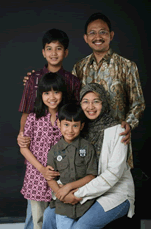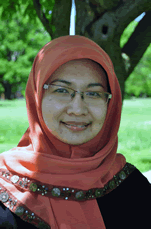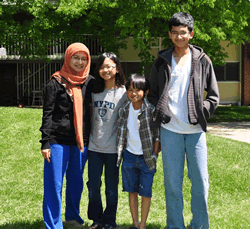CHAPTER 3: Sophie Dewayani
Like Shafinaz, Sophie, who was born in Surabaya, Indonesia, in April 1972, claims something of her cultural background in her video, entitled “Space, Time, Limit.” The initial scenes in her video look no different from those typically presented by graduate students from the United States (see, for example, Hawisher, et al., 2010), but before long, rumbling sounds announce that the viewer can perhaps expect the unexpected. (Click on image below to access movie. It may take a few moments to load.)

Sophie's movie: “Space, Time, Limit”
As we watch Sophie's movie, we are greeted by a Midwestern morning and see children who, she writes, "left [her]" as they go off to school, the little girl following behind her brother. We see—and hear—the school bus leaving, the couch “with nobody,” “nothing here,” Sophie writes. The viewer sees a child’s teddy bear alone in a wagon, a deserted playground, empty swings—even the emptiness of the Midwestern terrain. And there is also the empty computer screen through which Sophie signals, as well as through the previous scenes, something of the anxiety she feels about writing. As the video continues, we also hear sounds stirring: the white noise of traffic and the wind, the dryer tossing clothes, the water from the faucet, the rain pouring—all disturbingly intense in their presentation. But, unlike Shafinaz’s video, there is no voiced-over narrative with Sophie, say, reading poetry or commenting on her early life; instead we see words and images on the screen accompanied only by a rush of sounds.
As Sophie waits for inspiration—as she listens—the academic books we now see as still images give her hope, and pages of her text appear on the computer screen. But just as importantly—startlingly, in fact—the scene shifts to the sound of Indonesian music, and viewers see the shadow of Javanese dancing: Sophie herself performing, with the performance reflected against the background of a brick wall. The viewer never sees Sophie except in the silhouettes of her dancing and therefore must interpret the meaning she seeks to convey through the use of audio and still and moving images, without ever hearing her voice. Sophie thus constructs for the viewer a bit of her literate life that crosses cultural imaginings and grounds itself in everyday experience.
As she presents her literacy narrative through her video, however, Sophie is always conscious of her Indonesian heritage. She explains, "I feel like I have a kind of moral responsibility to endorse a different face of Indonesia in a way different from those depicted by the media even in academic assignments."
But academic assignments for Sophie, as for Shafinaz, have not always been transparent in their English-language expectations and culturally inflected requirements. She tells us:
"Once, a graduate assistant gave my paper back with a comment, 'Try not to use a first person voice.' Academic discourse meant to me a whole…system with a consensus on a uniform way of writing. I was struggling to fit in. While my language skill was judged by the numeric TOEFL and verbal GRE test, at the same time I was trying to situate what language ability tests could never reveal: my voice, intent, passion, imagery, nature of thought, and also myself."
We would argue that her writing process video begins to reveal these aspects of Sophie even though she is barely seen and never heard as the storyteller. And despite perceived difficulties with academic discourse, Sophie has persisted in her studies and has completed groundbreaking research on the oral literate culture of the Indonesian Baduy, whom she describes as “a small-scale indigenous community.” It would seem that once she overcame the obstacles of initial graduate requirements, she was able in more advanced graduate work to demonstrate through writing her highly perceptive thinking and research. She has also come to appreciate her experiences with digital media. As she puts it:
"I might be the one who [has] benefited from technology literacy. Being a non-English native speaker who was not exposed much to computers except for a little bit of e-mailing and browsing, I was in a certain way susceptible to computer anxiety not because my technological opportunities and experiences have been so severely limited, but because the computer was introduced to me as a set of mechanical tools with complicated programming languages and a 'foreign' domain separated from my professional and personal life."
Sophie’s response to technology is very similar to that of the participants in Literate Lives (2004) who, like Sophie, were born in the 1970s or earlier. Like these Literate Lives participants, Sophie came of age during the 1980s, when the concept of “computer literacy” seemed to demand the ability to program computers (Luehrmann and Peckhem, 1984), a requirement that probably had little to do with her living in Indonesia. In the United States, as well, programs like BASIC or Pascal and Logo for children were often viewed as necessary for those who would claim to be computer literate. Many at this time rejected computer technology as foreign and off-putting, only embracing it when introduced to user-friendly applications such as word processing and eventually screen editors for e-mail. Sophie’s experience as a graduate student in the United States since 2002, however, has given her a somewhat different understanding of computer technology. She states:
"Having engaged in multimedia writing such as Moodle and iMovie enabled me to look at technology in a different way. I cannot help but admit that in many ways, moodling and iMovie experiences give me more opportunities to contemplate and express my feelings and ideas better than oral practice."
Images of Sophie and her family on Facebook
She goes on to note that her experience in creating a video of her writing processes surprised her; it expanded her views about art and technology in ways that inspired creative thinking.
"I developed a similar sense as the one that I used to have when I wrote fictions: the freedom of expression, the creative way of capturing and expressing things, the bigger room to contemplate, and the allegory way of thinking. I believe one should master this lateral style of thinking beside the academic way we are used to encountering. I think I would not mind creating another project in the future."
This satisfying kind of experience with digital media was new to her and paved the way for helping her contemplate future encounters with technology in which she was not handicapped by computer anxiety. As she relates:
"When it comes to visual literacy, I always felt handicapped. Not only because of my ‘limited’ art talent, but also because visual literacy always reminded me of technology. I might be susceptible to computer anxiety, regarding my restricted experience with technology. I am not a kind of person who is glued to the computer. Thus my iMovie encounter was a little bit surprising this time [because] I really enjoyed it!"
Sophie reminds us that alphabetic literacy often represents only a portion of the meaning writers might want to convey and that when literate practices embrace a full range of modes and media (alphabetic, photographic, videographic, sonic), additional options for meaning-making become available. Both Sophie and Shafinaz were able to take advantage of this multimodal composing to express themselves as video authors in ways not previously available to them in academic settings.
We now turn to Yu-Kyung Kang and her literacy narrative.
previous < > CHAPTER 3: Yu-Kyung Kang




